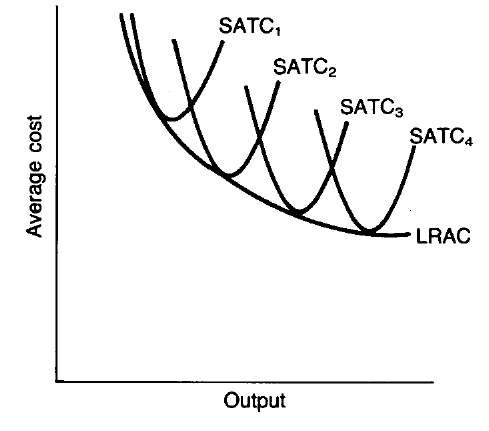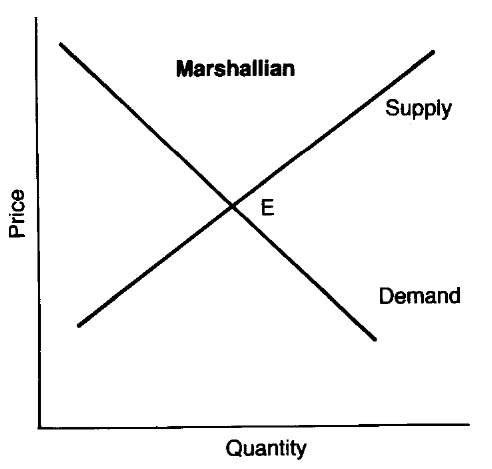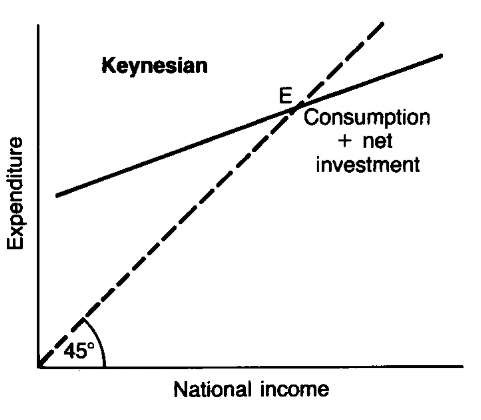entrepreneur
The fourth factor of production, after land, labour and capital, which organizes production and undertakes the risk of an enterprise. In joint stock companies, the risk bearing is undertaken by the shareholders; in small businesses, usually by the manager-proprietor. The idea of entrepreneurship was introduced into economics by cantillon, literally to mean the ‘undertaker’, i.e. a person who buys at a fixed price and sells at an uncertain price. subsequently different economists debated alternative definitions, which include risk-bearer, organizer of production, innovator and decision-maker in circumstances which give people unequal access to information. New entrepreneurs are often well-educated persons with managerial experience having small firms in areas with wealthy local markets.
envelope curve
A curve enclosing a whole family of curves, each of which contributes at least one point to the envelope. The main use of envelope curves is in relating long-run to short-run cost curves. in the figure SATC1-SATC4 are short-run average total cost curves; LRAC is the long-run average total cost curve.
environmental accounting
Accounting for the private and social costs of environmental events in national income accounting, financial accounting and MANAGEMENT ACCOUNTING.
environmental determinism
The doctrine that economic and social activities are determined by the physical environment, particularly the climate. Development economists ascribe to this determinism the lower incidence of development in some areas of the world and the international division of labour.
environmental issues
World population growth, the demand for exhaustible resources, the loss of topsoil and forests, and pollution are the principal matters discussed.
Environmental Protection Agency
Washington-based US federal agency established in 1970 for research into the environment and the control of pollution. It reinforces the efforts of other federal agencies and co-ordinates the anti-pollution enforcement work of state and local governments. it is concerned with air, water,radiation, solid waste, pesticides and toxic substances.
environmental tax
A tax on a polluter related to the external costs of private production.
EPA
A world econometric model of the Japanese Economic Planning Agency which includes nine country models (of the seven major OECD countries, Australia and South Korea) and six trading regions.
epidemic model
An explanation of the diffusion of technology using the analogy of the spread of infectious disease. The rate of diffusion is regarded as a function of the product of (1) the share of the population with a particular innovation and (2) the number of the fixed population without it. The model attempts to explain why a diffusion rate follows a sigmoid S-shaped time path with low initial rates, a quickening of diffusion, then a fall back to low rates as the potential for diffusion diminishes.
equality
The achievement of the same amount of economic welfare per head or the same economic opportunities for each individual. As the creed of egalitarianism, it denies differences in innate abilities and argues that superior abilities are merely the product of training.
equality of opportunity
1 Access by minority groups and the disadvantaged to education and everything necessary for full participation in society.
2 An absence of discrimination so that people are judged only by the personal attributes relevant to a particular task or activity. Individuals are responsible for outcomes.
equality standard
An idealistic approach to income distribution giving equal shares to all by equalizing per capita incomes. Critics of this approach assert that human nature is not so altruistic as to tolerate a system of reward which ignores differences in individual persons’ contributions to output. Also a fall in labour productivity is a likely consequence of using this policy.
equalizing wage differential
A wage differential which compensates a worker for a non-pecuniary aspect of a job, e.g. the degree of risk or the dirtiness of working conditions. These differentials discourage labour mobility to more pleasant occupations. cantillon and smith were both aware of this reason for wage differentials.
Equal Opportunities Commission
UK institution set up in 1976 to deal with complaints about sexual discrimination. initially the bulk of complaints concerned job adverts specifying applicants of a particular sex; subsequently the issues covered have included a wider range of grievances. it publishes annual statistics on sexual wage differentials.
Equal Pay Act 1963 (USA)
US federal statute which sought to equalize male and female pay for workers in interstate commerce. Employment discrimination against women and ethnic minorities was dealt with under Title VII of the Civil Rights Act 1964.
Equal Pay Act 1970 (UK)
UK legislation that enforced the principle of equal pay for equal work: this was to apply to all collectively bargained agreements and STATUTORY MINIMUM WAGE RATES by 1975. Despite the Act, there is still a divergence between male and female earnings, reflecting occupational segregation of women, differences in hours worked and promotion policies of firms.
Equal Pay Directive
A directive issued by the european commission in 1975 to counter discrimination in pay, especially on the grounds of sex.
equilibrium
A state of balance such that a set of selected interrelated variables has no inherent tendency to change. In economics, a major example is the balance of the forces equating demand and supply. smith in his discussion of prices used the idea of market prices fluctuating around the natural price which can be considered a central price. The subsistence theory of wages regarded expansions and contractions of a population as equilibrating forces making the subsistence wage rate the long-run equilibrium wage. An equilibrium can exist for an economy as a whole, for a sector of it, for a particular market or for an institution, such as a firm. Although the term is applied principally to static models, there can be an equilibrium in dynamic models when variables proceed along an equilibrium-type path. Equilibria can be stable or unstable, temporary or permanent: some of them do not exist. The Marshallian and Keynesian cross-diagrams are the most famous diagrammatical representations of equilibrium (E, equilibrium).
equilibrium GNP
The level of real national income at which AGGREGATE DEMAND equals AGGREGATE SUPPLY, i.e. desired expenditure equals the quantity of goods and services supplied in that economy.
equilibrium price
The price which equates demand and supply in a market in a particular time period.
equilibrium velocity
The velocity of circulation that maintains interest rates on deposits at their long-run equilibrium (i.e. average) rates.
equipment trust bond
A financial arrangement for leasing equipment. The holder of the bond owns the equipment and then leases it to the firm which has issued the bond via a trustee. The trustee pays the interest and principal to the bondholder, receiving rental payments from the issuer of the bond.
equity
1 ORDINARY SHARES.
2 COMMON STOCK.
3 The portion of a company’s capital which does not earn a fixed rate of interest. Equity holders usually receive dividends varying with the profitability of the company/corporation and its profit distribution policy. The issue of equity shares enables a company to expand its capital and to spread business risk.
4 Fairness.
equity comovement
The extent to which the prices of equities on different stock exchanges change by the same amount and in the same direction. The removal of exchange controls has increased the possibility of comovement.
equity joint venture
A business jointly owned and run by a private firm and a governmental organization. As it is financed partly by equity capital, the return to the private investor is a variable dividend. This arrangement was used by capitalist firms to invest in centrally planned economies. To the participating government there is the advantage of not having to pay fixed interest charges. Many East European countries turned to this organizational form after 1989 as a means of reconstructing their economies.
equity-linked mortgage
A method of purchasing commercial or residential property. The lender offers to pay, for example, half the current interest rate on the mortgage in return for acquiring half the equity in the property (or another proportion). This device makes it possible for borrowers to obtain finance for large property purchases and for lenders to benefit from the capital appreciation of properties.
equity premium
The excess of the average real return to stock market securities over the interest rate on treasury bills. In the USA this has been about 6 per cent for 100 years.
equity release scheme
A loan obtained by a house owner through taking out a mortgage on the property to buy a high-yield bond in order to provide an income. Falling house prices caused some owners to lose their homes.
equity-style management
The choice by a portfolio manager between large or small growth or value of a client’s investments where growth is measured by earnings growth and value is the ratio of price to book value of a share. A popular strategy is to choose growth at a reasonable price.
equity taxation
Taxation based on the fairness principle that each person should suffer an equal sacrifice. ‘Sacrifice’, however, is an ambiguous term as it can refer to equality in absolute terms or at the margin.
equity warrant
An option to buy an ordinary share or common stock at a fixed price in the future. It is issued in the form of a bond with a low coupon. In the case of Eurobonds, the warrant is issued attached to a bond denominated in a particular currency. However, the warrant is often detached and traded separately. The popularity of this cheap method of stock market speculation is reflected in the rapid increase in warrant prices.
equivalent variation
The minimum amount a person who gains from a change has to be given to forgo the change.
ergonomics
The scientific study of the physical methods of work with the aim of minimizing effort and maximizing output. Inspired by the study of the practical problems of using military equipment in the Second World War, it became a recognized discipline in 1949. Much work has been done on the appropriate ways of displaying information, on the study of machine controls and on the relationship between a worker and the physical environment.
error
The difference between observed and true values brought about by chance rather than systematically.
error-correction model
An econometric method of adjusting a policy instrument to keep a target variable close to its desired value used as early as 1954 by phillips.
escalator clause
A clause in a contract designed to revise payments due under that contract in line with changes in a specified price index. In times of considerable inflation, these clauses are popular in labour and building contracts, as well as in tax schedules and social security benefits tables.
establishment
A place of business, a factory or a plant which is part or the whole of a firm.
estate economy
An underdeveloped economy with much of its agriculture organized into large estates, usually foreign owned. Malaysia with its rubber plantations, Ceylon with its tea plantations and Argentina with its cattle ranches had this character. Although wages of the estate workers were low by international standards, they were high enough to induce the movement of workers from subsistence agriculture. These estates were the basis of development in several ex-colonial countries.
e-tail company
A company which retails its goods and services using e-mail.
ethical unit trust
UK equivalent of a social conscience fund.
Euler’s theorem
The rule that if factors of production are paid according to their marginal products, the total product will be distributed completely if and only if there are constant returns to scale. The theorem is of importance when considering the application of the marginal productivity of wages since if there are diminishing returns and workers are paid according to their marginal products, the total wage bill will be less than the total product. conversely, if there are increasing returns to scale and workers’ wages equal their marginal products, the total wage bill will be more than the value of their output.
euro
The common currency of the european union adopted by all member states excepting Denmark, Sweden and the UK. It came into force on 1 January 1999 in parallel with the currencies of participating states. Euro coins and notes were issued from 1 January 2002 and became the sole currency in circulation in the states of the eurozone by 28 February 2002. Soon after its inception it experienced a slump in its value.
Eurobank
A bank able to receive time deposits and make loans in currencies other than that of the country in which it is located.
Eurobond
A long-term bond marketed internationally by an international syndicate of banks in countries other than the country with the currency in which the bond is denominated, e.g. a bond in French francs can be marketed anywhere outside France. The advantage of this type of financial instrument is that it escapes national financial regulations.
Eurobond market
An international market, founded in the early 1960s, as a primary and secondary market in bearer bonds issued outside the country of that particular currency. The anonymity of this market has attracted investors who wish to remain discreet about their holdings. Previously able to avoid any regulation, it is now under the ASSOCIATION OF INTERNATIONAL BOND DEALERS in the UK. It has become a leading world securities market.
Eurocheque
A cheque that can be written in any one of a number of currencies.
Euroclear
An international agency for clearing bank cheques between ten European countries.
Eurocurrency market
The international market dealing in bank deposits in the major currencies, including the US dollar, yen, Deutschmark, Swiss franc, French franc, guilder and ecu, which has been in existence since the 1950s. its early growth was stimulated by regulation q which encouraged the expatriation of US dollars in search of higher interest rates.
Eurodollar
Dollars on deposit with banks outside the USA, some of them the European branches of US banks. Originally, the attraction of such deposits was that they could evade the reserve requirements needed for domestic deposits and any restrictions on maximum interest rates (regulation q). As a consequence of US balance of payments deficits, dollars are supplied for the reserves of the central banks other than the federal reserve system. Increases in Eurodollar deposits are encouraged by the investment facilities and interest rates of the Eurobanks. There is also a small creation of Eurodollars by the Eurobanks themselves.
Eurodollar market
A wholesale money market dealing in expatriate US dollars, outside the control of national banking authorities. However, increasingly the bank of England, the Bundesbank and the US federal reserve banks have introduced controls on the foreign banks within their jurisdiction. Despite these controls, the banks operating in this market are more competitive than other commercial banks because their operating costs are lower as a consequence of the insistence on minimum deposits of at least £50,000.
Euroequity
An equity of one country which is issued or sold in another, e.g. the sale of Fiat shares in Germany.
A franc deposit in a non-French bank in Europe but outside France.
euro interbank offered rate
The interest rate at which euro interbank term deposits of the eurozone are offered by one prime bank to another.
Euroland
The member states of the European Union in the european monetary union using the euro as their currency.
Euromarket
A financial market trading in financial instruments that are denominated in currencies other than that of the country where that market is located, e.g. London trading in bonds denominated in French francs.
Euromoney deposit
A bank deposit in another currency, e.g. US dollars, French francs, Swiss francs and yen.
Euronext
The stock exchange formed by the merger of the exchanges of Amsterdam, Brussels and Paris in September 2000. This cross-border exchange began with trading in over 1,600 securities.
Euro overnight index average
The effective overnight interest rate of the panel banks in the euro interbank market.
European Bank for Reconstruction and Development
The development bank founded in 1991 and based in London which lends to the East European countries in order to ease their transition from centrally planned to market economies. its capital was raised from european community institutions and forty-one countries. its lending policy is to make 40 per cent of its loans for infra structure investment and 60 per cent for private sector commercial investment.
European Central Bank
Established in June 1998 and located at Frankfurt, Germany. it conducts monetary policy for all the twelve European countries using the euro as their only currency. It has a six-member Executive Board, a Governing council consisting of the members of the Executive Board and the governors of the central banks using the single currency, and a General council which includes governors of central banks of the European union not using the single currency (they are not allowed to vote).
European Communities
The three organizations consisting of the European coal and steel community, established in 1952, the european economic community, established in 1958, and the European Atomic Energy Community, also established in 1958. The original member states of each of the three communities were France, West Germany, Italy, Belgium, the Netherlands and Luxemburg. in 1967 the original institutional structures of the three communities were merged to create the common executive, judicial and legislative institutions of the EUROPEAN COMMUNITY.
European Community
The name given to the european communities since 1967. The original six member states (France, West Germany, italy, Belgium, the Netherlands and Luxemburg) were joined, in 1973, by the uK, ireland and Denmark, followed by Greece in 1982, and Spain and Portugal in 1986. The signatory countries of the European community hoped to promote a greater equality of incomes between nations and regions, to raise the rate of economic growth, to help Third World countries and to establish a major economic power, rivalling the USA and the USSR. By 1987, the European Community had a population of 323 million inhabitants, making it the largest market in the industrialized world (USA, 244 million; Japan, 122 million), but Japanese per capita income was then 48 per cent higher and US per capita income 40 per cent higher than in the European Community. The industrial strength of the European Community lies especially in its chemical, transport equipment and industrial machinery industries.



